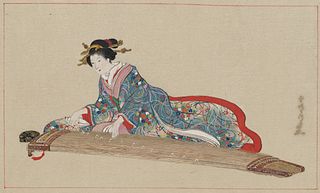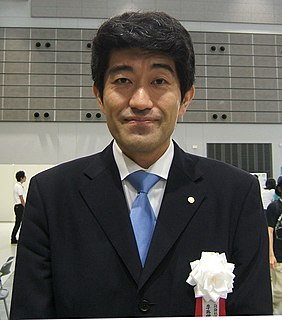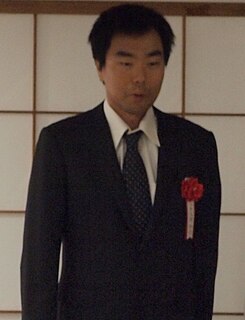Ryoko Yamagishi is a Japanese manga artist. She is one of the Year 24 Group, a collection of female artists who innovated shōjo (girls') manga throughout the 1970s. Her major works include Hi Izuru Tokoro no Tenshi and Maihime Terpsichora.
Kudan Project Production is a theatrical company for whom Tengai Amano writes and directs. They are only 2 actors, Hideji Oguma and Satoru Jitsunashi.

Yasuo Kobayashi is a Japanese aikido teacher holding the rank of 8th dan Aikikai.

Machiko Satonaka is a Japanese manga artist. She made her professional debut in 1964 during her second year of high school with the one-shot Pia no Shōzō. She has since created nearly 500 manga in a variety of genres. Two of her most notable works are Ashita Kagayaku, which won the 1974 Kodansha Publishing Culture Award, and Karyūdo no Seiza, which won the 1982 Kodansha Manga Award. In addition to creating manga, Satonaka teaches at the Osaka University of Arts as the head of the Character Creative Arts Department and serves on the board of various manga-related organizations in Japan.

Banchō (番町) is an area in Chiyoda, Tokyo, Japan, consisting of the six "-banchō" districts, Ichibanchō (一番町) to Rokubanchō (六番町), as well as parts of Kudanminami and Kudankita, and Fuijimi.
Kudanminami (九段南) is a district of Chiyoda, Tokyo, Japan, consisting of 1-chōme to 4-chōme. As of March 1, 2007, its population is 2,431.

Kudankita (九段北) is a district of Chiyoda, Tokyo, Japan, consisting of four chōme. It was a part of the former ward of Kōjimachi. As of March 1, 2007, its population is 1,404. Kudankita is a luxury and prestigious residential and business zone.

Danmono is a traditional Japanese style of instrumental music for the koto. The few pieces of its repertoire were mostly composed and developed in the seventeenth century, and all follow a strict form of composition.

Part of the Banchō area, Sanbanchō (三番町) is an upscale, mostly residential district of Chiyoda, Tokyo, Japan. As of June 2020, the population of this district is 3,666 in 1,707 households. It borders the Tokyo Imperial Palace and the Chidorigafuchi moats to the east, Nibanchō and Yonbanchō to the west, Ichibanchō to the south, and Kudanminami to the north.

Chiyoda is a special ward located in central Tokyo, Japan. It is known as Chiyoda City in English.

The Residence of the Philippine Ambassador to Tokyo, informally known as the Kudan (九段), is the official residence of the Philippine ambassador to Japan. It is located in 1-1-1 Fujimi, Chiyoda-ku, Tokyo, Japan. It is called the "crown jewel of Philippine foreign service" and became the first officially designated National Historical Landmark outside Philippine soil.

The kudan is a yōkai of a "prophecy beast" type, whose news or urban legend has been disseminated in Japan since the Edo Period.

Toshiaki Kubo is a Japanese professional shogi player ranked 9-dan. He is a former Ōshō and Kiō title holder.

Toshiyuki Moriuchi is a Japanese professional shogi player, ranked 9-dan. He is a Lifetime Meijin who won the title eight times, and also a former Ryūō, Kiō and Ōshō title holder. He is also a former senior managing director of the Japan Shogi Association.
Nobuyuki Ōuchi is a deceased Japanese professional shogi player who achieved the rank of 9-dan.He won the first Kiō title in 1976, and also served as senior managing director of the Japan Shogi Association from 1993 to 1999. He was awarded the Japanese government's Order of the Rising Sun in 2015.

Hiroyuki Miura is a Japanese professional shogi player, ranked 9-dan. He is a former Kisei title holder and became the first active Class A professional to lose to a computer when he lost to the GPS Shogi program in April 2013.

Keita Inoue is a Japanese professional shogi player, ranked 9-dan. He is currently serving as an executive director of the Japan Shogi Association.

Osamu Nakamura is a Japanese professional shogi player, ranked 9-dan. He is a two-time winner of the Ōshō title, and the current president of the Professional Shogi Players Group.
Shōko Kubo is a Japanese women's professional shogi player ranked 2-kyū.













